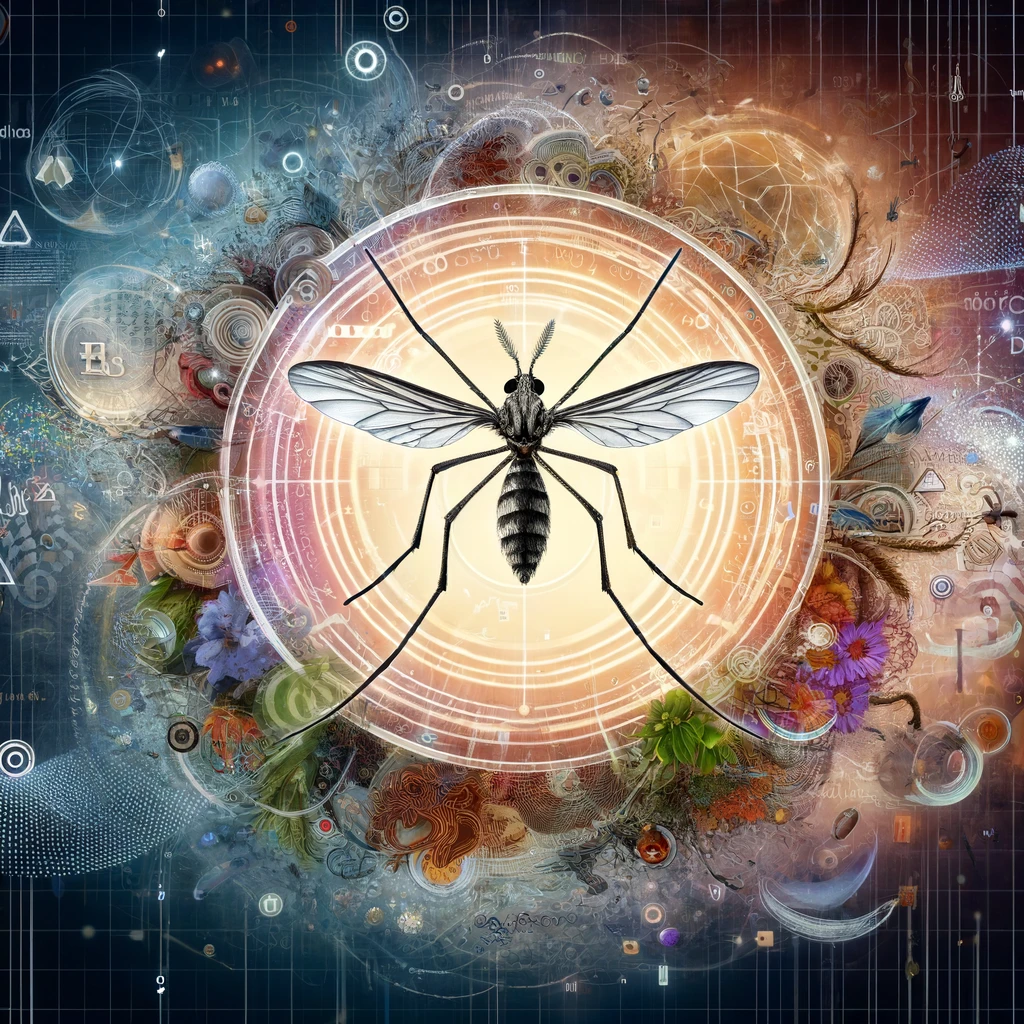The fight against dengue fever, a disease transmitted by the Aedes aegypti mosquito, has been an ongoing battle for tropical and subtropical countries around the world. Every year, millions are affected, resulting in vast impacts on public health, the economy and society.
Contudo, uma nova esperança surge no horizonte tecnológico: a aplicação da inteligência artificial (IA) na detecção precoce e controle de focos do mosquito transmissor da dengue.
This breakthrough not only promises to revolutionize dengue prevention strategies, but also strengthen global public health efforts by integrating advanced technology into disease surveillance and control.
With AI, we are on the cusp of an era where dengue detection and prevention can be significantly improved, augmenting human efforts with unprecedented accuracy and effectiveness.
This article dives into the heart of this innovation, exploring how artificial intelligence is becoming a crucial tool in the fight against dengue, turning data into preventative action and saving lives with algorithms.
Browse the content

The Dengue Challenge
When we talk about dengue fever, we are referring to one of those diseases that have the ability to spread rapidly, especially in densely populated urban areas.
If you've ever lived in or visited a tropical region, you've probably heard the constant calls from health authorities to avoid standing water and use insect repellent.
This is because the Aedes aegypti mosquito, the little villain behind the transmission of dengue fever, likes warm, humid places to proliferate.
But why is dengue such a challenge? Well, for starters, the numbers are frightening. Imagine, every year, hundreds of millions of people are infected globally, and in some cases, this can lead to more severe forms of the disease, such as dengue hemorrhagic fever, which can be fatal.
Furthermore, dengue places immense pressure on health systems, especially in developing countries where resources are limited.
Prevention has been a constant challenge. Although we have vaccines and mosquito control measures, such as fumigation and elimination of breeding sites, the reality is that these traditional approaches often prove insufficient.
Mosquitoes are cunning creatures, and even small amounts of standing water can become a breeding ground for them. In addition, climate change and rapid urbanization are expanding the areas where they can breed.
Artificial Intelligence: A New Frontier in Public Health
So where does artificial intelligence fit into this? Think of AI as a super-powered detective, one that never sleeps, armed with data and algorithms capable of identifying patterns that we humans often fail to see. In the context of dengue, AI is being trained to identify potential mosquito breeding sites long before they become a problem.
Imagine using drones equipped with high-resolution cameras to fly over suspected areas, capturing images that are then analyzed by AI systems to identify standing water or trash that could serve as breeding grounds for mosquitoes. This approach is not only faster but also more comprehensive than human inspections, allowing preventive action to be taken long before a dengue outbreak begins.
Additionally, AI can predict dengue outbreaks by analyzing climate data such as temperature and humidity, along with information about previous outbreaks and human movement patterns.
These predictive models can be incredibly accurate, giving public health professionals a powerful tool to act proactively, focusing resources and prevention efforts on the areas most in need.
Emerging Technologies in the Fight Against Dengue
There are already impressive examples of how the technology is being applied. One project in Australia, for example, is using AI to analyze data collected by smart mosquito traps.
These traps are capable of identifying Aedes aegypti among hundreds of other mosquito species, allowing specific control actions in these locations.
In Brazil, a country hit hard by dengue fever, startups are developing apps that allow citizens to report potential dengue outbreaks via their smartphones.
This information feeds AI systems that help health authorities map and respond quickly.
Development and Implementation of AI in Dengue Detection
Despite the potential, the implementation of these technologies faces challenges.
The accuracy of AI models depends on the quantity and quality of data available.
Furthermore, in many places, the technological infrastructure and training of health professionals to work with these new tools are still limited.
However, progress is not stopping. Partnerships between governments, research institutions and private companies are forming around the world with the aim of overcoming these obstacles.
Pilot projects are being launched to test and improve these technologies, with some already showing promising results.
Let’s pause here to check if the content aligns with your expectations or if there are any adjustments you would like to make before we move on to the next sections on the impact and future of AI in dengue prevention, as well as the ethical and social considerations involved.
Impact and Future of AI in Dengue Prevention
The incorporation of AI into the fight against dengue is already yielding tangible results. From reducing the time needed to identify mosquito breeding sites to the ability to predict outbreaks weeks in advance, the benefits are clear. But the impact goes beyond the numbers.
We’re talking about lives saved, hospitalizations avoided, and entire communities preserved from devastating outbreaks.
One fascinating aspect of this evolution is how AI is democratizing dengue prevention. Apps that allow citizens to report potential mosquito breeding sites are turning every smartphone user into a public health watchdog.
This collaborative approach, powered by AI, exponentially amplifies authorities’ monitoring and response capabilities.
The Future is Now
But what does the future hold for AI in dengue prevention? As we move forward, we can expect to see increasingly sophisticated algorithms capable of integrating an even wider range of data, from population migration patterns to changes in the environment that may affect mosquito breeding.
Furthermore, the convergence of AI with other technologies, such as gene editing and robotics, could lead to innovative and previously unimaginable solutions.
Imagine genetically modified mosquitoes incapable of transmitting dengue fever, released and monitored by smart drones, all coordinated by AI systems that ensure the effectiveness and safety of the operation.
Ethical and Social Considerations
With great power comes great responsibility. The adoption of AI in public health, particularly in the detection and prevention of dengue fever, is not without its ethical and social dilemmas. Issues such as data privacy, consent and equity in access to technological solutions are crucial.
It is critical to ensure that the benefits of AI are accessible to everyone, regardless of geographic location or socioeconomic status.
Furthermore, there must be transparency about how data is collected, analyzed and used, ensuring that the use of AI respects individual rights and promotes the common good.
Navigating the Future with Care and Collaboration
As we move forward, continued collaboration between data scientists, epidemiologists, healthcare professionals, and the broader community will be crucial.
The exchange of knowledge and experiences between these groups not only enhances the development of more effective AI solutions against dengue, but also ensures that these solutions are applied in an ethical and responsible manner.
The Importance of Open Access and Education
To maximize the positive impact of AI in the fight against dengue, it is essential to promote open access to these technologies. This means not only making data transparently available, but also investing in education and training so that communities around the world can use these tools effectively.
Education plays a dual role here: it not only empowers people to use technology, but also raises awareness about dengue and how to prevent it. By better understanding the risks and prevention measures, communities can become active partners in the fight against this disease.
AI as a Complement, Not a Replacement
It is vital to recognize that while AI offers powerful tools in dengue prevention, it does not replace the need for informed public health efforts and responsible individual action.
Success in the fight against dengue depends on a multifaceted approach that includes not only technology, but also education, adequate infrastructure and efficient public health policies.
Looking to the Future
As we look to the future, we can see a horizon where AI becomes a central piece in the prevention and control of diseases like dengue. But this vision will only become a reality if we work together to ensure that the technology is developed and implemented in an ethical, responsible and inclusive way.
The road ahead is filled with challenges, but also unprecedented opportunities. By joining forces between technology and humanity, we can aspire to a world where dengue and other communicable diseases no longer pose the threat they do today.
Conclusion
The fight against dengue fever is being transformed by artificial intelligence, with promises of a future where the disease can be controlled more effectively and efficiently. The challenges are real, but the opportunities are immense.
We are witnessing a revolution in public health, where technology, in harmony with human efforts, is paving the way for a healthier world.
Now is the time to embrace this change, support innovation and work together – governments, the private sector, communities and individuals – to ensure that the promise of AI in dengue prevention becomes a reality for everyone.
Because, at the end of the day, true intelligence is the ability to save lives.
